The NVIDIA GeForce GTX 1660 Ti Review, Feat. EVGA XC GAMING: Turing Sheds RTX for the Mainstream Market
by Ryan Smith & Nate Oh on February 22, 2019 9:00 AM ESTPower, Temperature, and Noise
As always, we'll take a look at power, temperature, and noise of the GTX 1660 Ti, though as a pure custom launch we aren't expecting anything out of the ordinary. As mentioned earlier, the XC Black board has already revealed itself in its RTX 2060 guise.
As this is a new GPU, we will quickly review the GeForce GTX 1660 Ti's stock voltages and clockspeeds as well.
| NVIDIA GeForce Video Card Voltages | ||
| Model | Boost | Idle |
| GeForce GTX 1660 Ti | 1.037V | 0.656V |
| GeForce RTX 2060 | 1.025v | 0.725v |
| GeForce GTX 1060 6GB | 1.043v | 0.625v |
The voltages are naturally similar to the 16nm GTX 1060, and in comparison to pre-FinFET generations, these voltages are exceptionally lower because of the FinFET process used, something we went over in detail in our GTX 1080 and 1070 Founders Edition review. As we said then, the 16nm FinFET process requires said low voltages as opposed to previous planar nodes, so this can be limiting in scenarios where a lot of power and voltage are needed, i.e. high clockspeeds and overclocking. For Turing (along with Volta, Xavier, and NVSwitch), NVIDIA moved to 12nm "FFN" rather than 16nm, and capping the voltage at 1.063v.
| GeForce Video Card Average Clockspeeds | |||||
| Game | GTX 1660 Ti | EVGA GTX 1660 Ti XC |
RTX 2060 | GTX 1060 6GB | |
| Max Boost Clock |
2160MHz
|
2160MHz |
2160MHz
|
1898MHz
|
|
| Boost Clock | 1770MHz | 1770MHz | 1680MHz | 1708MHz | |
| Battlefield 1 | 1888MHz | 1901MHz | 1877MHz | 1855MHz | |
| Far Cry 5 | 1903MHz | 1912MHz | 1878MHz | 1855MHz | |
| Ashes: Escalation | 1871MHz | 1880MHz | 1848MHz | 1837MHz | |
| Wolfenstein II | 1825MHz | 1861MHz | 1796MHz | 1835MHz | |
| Final Fantasy XV | 1855MHz | 1882MHz | 1843MHz | 1850MHz | |
| GTA V | 1901MHz | 1903MHz | 1898MHz | 1872MHz | |
| Shadow of War | 1860MHz | 1880MHz | 1832MHz | 1861MHz | |
| F1 2018 | 1877MHz | 1884MHz | 1866MHz | 1865MHz | |
| Total War: Warhammer II | 1908MHz | 1911MHz | 1879MHz | 1875MHz | |
| FurMark | 1594MHz | 1655MHz | 1565MHz | 1626MHz | |
Looking at clockspeeds, a few things are clear. The obvious point is that the very similar results of the reference-clocked GTX 1660 Ti and EVGA GTX 1660 Ti XC are reflected in the virtually identical clockspeeds. The GeForce cards boost higher than the advertised boost clock, as is typically the case in our testing. All told, NVIDIA's formal estimates are still run a bit low, especially in our properly ventilated testing chassis, so we won't complain about the extra performance.
But on that note, it's interesting to see that while the GTX 1660 Ti should have a roughly 60MHz average boost advantage over the GTX 1060 6GB when going by the official specs, in practice the cards end up within half that span. Which hints that NVIDIA's official average boost clock is a little more correctly grounded here than with the GTX 1060.
Power Consumption
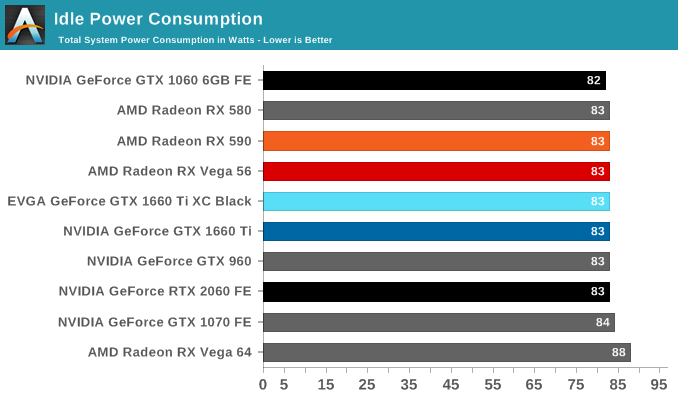

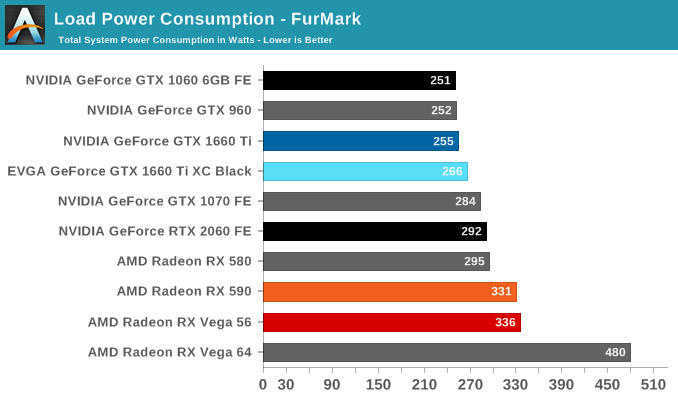
Even though NVIDIA's video card prices for the xx60 cards have drifted up over the years, the same cannot be said for their power consumption. NVIDIA has set the reference specs for the card at 120W, and relative to their other cards this is exactly what we see. Looking at FurMark, our favorite pathological workload that's guaranteed to bring a video card to its maximum TDP, the GTX 960, GTX 1060, and GTX 1660 are all within 4 Watts of each other, exactly what we'd expect to see from the trio of 120W cards. It's only in Battlefield 1 do these cards pull apart in terms of total system load, and this is due to the greater CPU workload from the higher framerates afforded by the GTX 1660 Ti, rather than a difference at the card level itself.
Meanwhile when it comes to idle power consumption, the GTX 1660 Ti falls in line with everything else at 83W. With contemporary desktop cards, idle power has reached the point where nothing short of low-level testing can expose what these cards are drawing.
As for the EVGA card in its natural state, we see it draw almost 10W more on the dot. I'm actually a bit surprised to see this under Battlefield 1 as well since the framerate difference between it and the reference-clocked card is barely 1%, but as higher clockspeeds get increasingly expensive in terms of power consumption, it's not far-fetched to see a small power difference translate into an even smaller performance difference.
All told, NVIDIA has very good and very consistent power control here. and it remains one of their key advantages over AMD, and key strengths in keeping their OEM customers happy.
Temperature
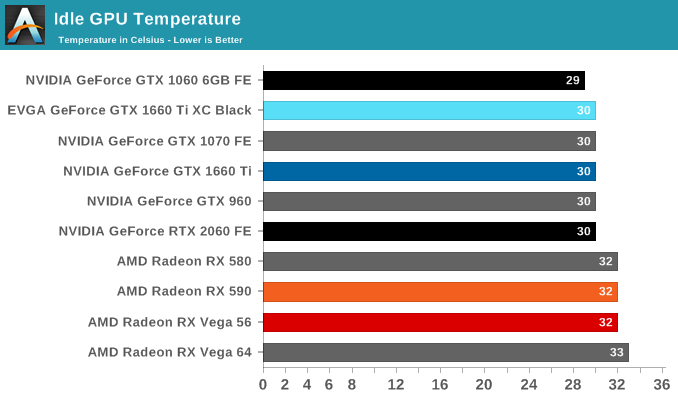
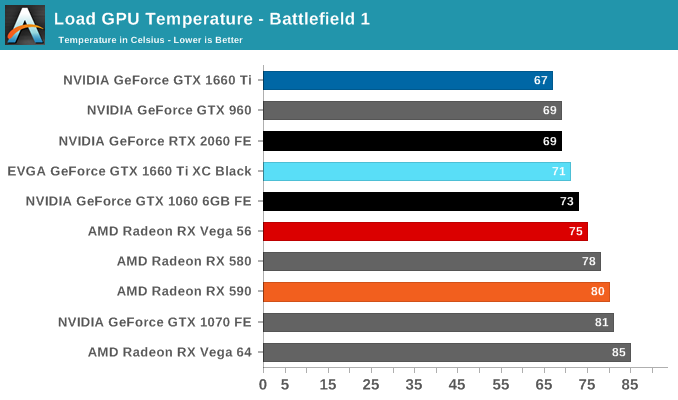

Looking at temperatures, there are no big surprises here. EVGA seems to have tuned their card for high performance cooling, and as a result the large, 2.75-slot card reports some of the lowest numbers in our charts, including a 67C under FurMark when the card is capped at the reference spec GTX 1660 Ti's 120W limit.
Noise

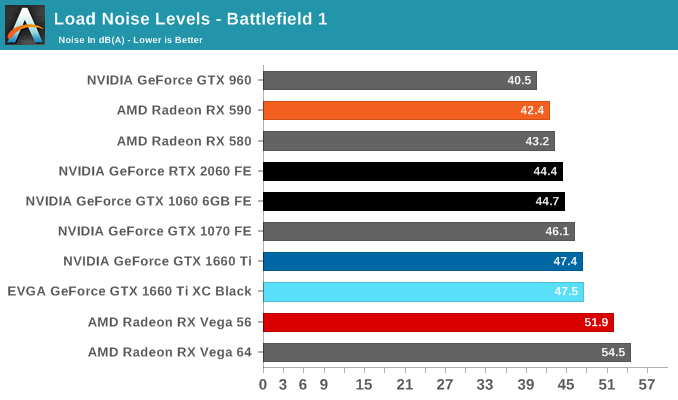

Turning again to EVGA's card, despite being a custom open air design, the GTX 1660 Ti XC Black doesn't come with 0db idle capabilties and features a single smaller but higher-RPM fan. The default fan curve puts the minimum at 33%, which is indicative that EVGA has tuned the card for cooling over acoustics. That's not an unreasonable tradeoff to make, but it's something I'd consider more appropriate for a factory overclocked card. For their reference-clocked XC card, EVGA could have very well gone with a less aggressive fan curve and still have easily maintained sub-80C temperatures while reducing their noise levels as well.










157 Comments
View All Comments
Oxford Guy - Saturday, February 23, 2019 - link
"The NVIDIA GeForce GTX 1660 Ti Review, Feat. EVGA XC GAMING: Turing Sheds RTX for the Mainstream Market"The same idea, restated:
"NVIDIA Admits, With Its GeForce GTX 1660 Ti Turing, That RTX Isn't Ready For The Mainstream"
just6979 - Saturday, February 23, 2019 - link
Why disable all AMD or NVidia specific settings? Any using those cards would have those settings on... shouldn't the number reflect exactly what the cards are capable of when utilizing all the settings available. You wouldn't do a Turing Major review without giving some numbers for RTX ON in any benchmarks that supported it...CiccioB - Monday, February 25, 2019 - link
Yes, the test could be done with specific GPU features turned on, but you have to clearly say what are the advantage of each particular addition on the final image quality.Because you can have (optional) effects that cuts frame rate but increase the quality a lot. So looking only at the mere final number you may conclude that a GPU is better than another because it is faster (or just costs less), but in reality you are comparing two different kind of quality results.
It's not different than testing two cards with different detail settings (without stating which they are) and then trying to understand which is the better one only based on the frame rate results (which is the kind of results that everyone looks at).
jarf1n - Sunday, February 24, 2019 - link
load power consuption is wrong,if you want see only gpu measured,measured only gpu like techpowerup doing.its clear if you measure total load,its not show it right.
134W 1660ti
292W vega 56
source:techpowerup
its clear that gtx 1660 ti is much much better gpu for at least FHD and QHD also.
huge different.
CiccioB - Monday, February 25, 2019 - link
Well, that however does not tell the entire story.The ratios versus the total consumption of the system is also important.
Let's say that for a gaming PC you already have to use 1000W. A card that suck 100W more just wastes 10% more of your power. Meanwhile if your PC is using 100W, such a card will be doubling the consumption. As you see the card is always using 100W more, but the impact is different.
Let's make a different example: your PC uses about 150W in everyday use. You have to buy an SSD. There are some SSD that consumes twice the power of others for the same performances.
You may say that the difference is huge.
Well, an SSD consumes between 2 and 5W. Buying the less efficient (5W) is not really going to have an impact on the total consumption of your PC.
ilkhan - Sunday, February 24, 2019 - link
Coming from a GTX970 and playing on a 2560x1600 monitor, which card should I be looking at?Ryan Smith - Monday, February 25, 2019 - link
You'd likely want an RTX 2060, if not a bit higher with the RTX 2070.https://www.anandtech.com/bench/product/2148?vs=23...
Mad Maxine - Monday, February 25, 2019 - link
Price is still crap for the performance. We live in a age now that sees Hardware and software no longer growing. And a GPU from 2012 Can still run all modern games today. Market is not going to be huge for Overpriced GPUs that are really not that much of a improvement from 2012.Oxford Guy - Monday, February 25, 2019 - link
Telemetry is growing. You are "your" data.bhanavi - Tuesday, February 26, 2019 - link
Thanks you so much for the informationhttps://apkmabbu.com
https://apkmabbu.com/gbwhatsapp-apk/
https://apkmabbu.com/ac-market-apk/
https://apkmabbu.com/lucky-patcher-apk/